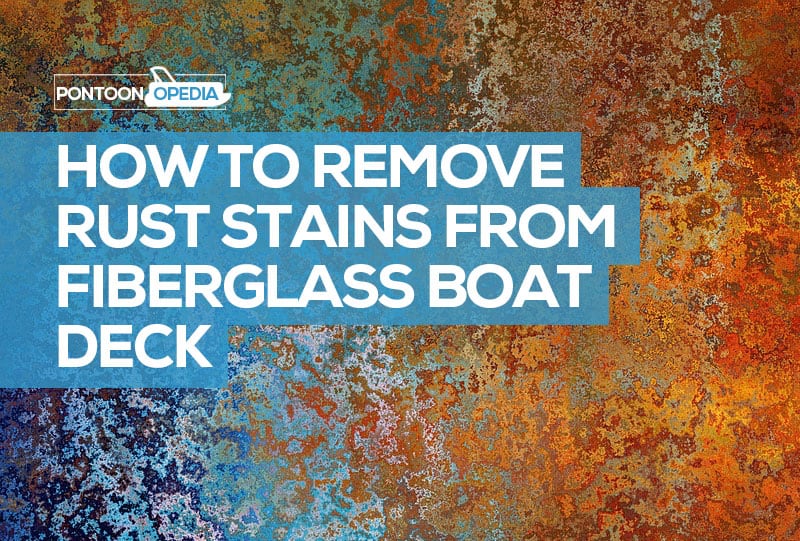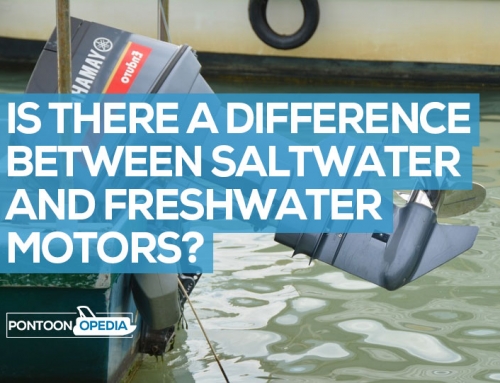A fiberglass boat is a great investment as it can last for many decades. In fact, many of the mechanical and electrical systems will fail long before the fiberglass begins to break down.
Fiberglass is a great material because it is cheap, strong and lightweight making it ideal for boating. However, one disadvantage of fiberglass is that it stains relatively easy and the key culprit is rust. This rust is usually evident at the base of all deck mounted hardware.
This article will explain the causes of rust stains on your boat, how to remove them and what to do in future to make sure that they don’t return. We will also briefly discuss the best type of cleaning chemical to use.
What causes rust stains?
You may be quite surprised to see rust stains on your boat because after all it is pretty common practice to use stainless steel on a boat because it has such excellent corrosion properties.
But stainless steel is at its heart still mostly iron with a few alloying elements added in to modify its properties. There are three main classes of stainless steel as listed below:
- Martensitic – Typically used on cutlery.
- Ferritic – Used for automotive trim applications.
- Austenitic– These are typically series 300 steels that are used in marine applications.
Marine grade stainless steel has a high nickel content, up to 6%, Therefore has very high corrosion resistance.
There are two main austenitic stainless-steel grades namely 304 and 316. 304 stainless steel contains 18% chromium and 8% nickel whereas 316 stainless steel has 16% chromium, 8% nickel and 2% molybdenum.
The molybdenum in 316 stainless steel is very import in as it resists crevice corrosion whereas the chromium in both the 304 and 316 steel bonds with oxygen to form a layer of chromium oxide that prevents further corrosion.
This layer can usually regenerate if it is exposed to oxygen but if continuously exposed to an electrolyte like water even stainless steel will corrode.
There are many places in a boat where fasteners and other steel parts can be exposed to water for long enough periods for corrosion to take place.
Over time this rust will begin to stain your fiberglass.
Another possible source of a rust stain will be if you decide to use a grinder on your deck to cut some steel for whatever reason. The steel dust will rust very quickly and leave a lot of rust spots on the deck, so if you are thinking of cutting on or near your deck, think again.
Another possible cause of rust stains will be from galvanic corrosion. If steel is used in conjunction with another metal in the presence of an electrolyte the then there is a good chance that galvanic corrosion will occur.
Make sure that you keep dissimilar metals from touching each other and if there is no other way make sure that the two metals do not come into direct contact with each other by using a rubber gasket.
How to remove rust stains from a fiberglass boat deck
Now that we know the causes of rust on a boat, we can begin to get into how best to remove these stains.
We will go through some basic steps on how to properly remove rust stains as well as stop them from returning.
1: Remove the hardware from the deck
It is likely that there are rust stains wherever hardware such as stanchions are fixed to the deck. You might see the rust stains seeping from all these areas. There is a good chance that the reason there is rust under the hardware is a combination of sub grade fasteners as well as water stagnating under it.
This promotes corrosion by turning the steel from passive to active.
This happens because of it being exposed to an electrolyte like water without allowing the protective layer to form again.
In order to properly clean these areas, you will need to remove all the fixtures.
This will also give you the chance to replace any corroded fasteners; make sure to replace all fasteners with 316 steel and not 304 steel.
They are a bit more expensive but will last a lot longer and are more resistant to corrosion.
2: Prepare the fiberglass boat deck
Once you have successfully removed all the hardware from the deck you can begin preparing for cleaning.
Rust stains are known as mineral stains.
Never use a strong solvent like MEK or acetone as these solvents can irreparably damage the gel coat layer.
Also, don’t use any abrasive past or sandpaper to remove stains, you will definitely make the problem far worse.
Next you will wash the deck with simple soap and water, this will do exactly nothing to the rust stain but will give a clean deck to work off from.
3: Clean the rust stains off the fiberglass boat deck
Mineral stains like rust require a special type of cleaner that contains acid and a chelating agent.
These rust removers work in two steps, first the acid dissolves the rust and the chelating agent holds the rust in suspension until it is washed away.
There are many different compounds that claim to remove rust stains, but one of the better ones can is this fiberglass stain remover on Amazon.
It must be noted that because this is a chemical reaction, it is not necessary to engage in excessive scrubbing.
Instead let the cleaning agent do its work and lightly wipe off and wash away the remnants when done.
If there are still stains present, you will need to literally rinse and repeat.
4: Wash the fiberglass deck down after removing the rust
Once you have cleaned off all the rust stains from the deck you can thoroughly wash the deck to remove any cleaning agent that may have stayed behind.
Make sure you properly rinse your deck off so that there are no chemical residues pooling somewhere.
You can now proceed to apply some wax to protect the deck and to make future stain removal significantly easier.
5: Polish the fiberglass deck down after washing
If your gel coat still looks drab and dull you can buff the surface to a bright shine.
This can be done with a power buffer to save time and sweat, some key points to take note of; firstly, when using an orbital sander, it is best to keep the sander moving at all times because leaving it stationary in one place will damage the gel coat layer.
When deciding on a polishing kit, make sure not to use the kind that contains aggressive abrasives in it. I love this polish and wax kit available on Amazon.
6: Reinstall deck hardware removed previously
Finally, you will need to re install all the hardware that you previously removed.
Make sure you have bought some new 316 fasteners, including 316 washers and nuts where required.
Before reattaching the hardware, you will need to apply some bedding compound not only to where the fasteners pass through the deck but also to the whole base of the hardware to stop moisture ingress in the future and to reduce future rust build up.
More information and related questions
How to remove water stains from a fiberglass boat
Stains can develop on your hull from keeping the boat in dirty water for long periods of time as well as calcium and scum growth. These types of stains are best handled by a strong acid formulation.
This can be applied with a rag but make sure that you have the correct gloves so that you don’t get acid on your hands, a good pair of googles is also a god idea to stop any random splashes from going into your eyes.
How to remove hull oxidation stains from you boat
Over time the gel coat on your hull will begin to oxidize, this is inevitable on a fiberglass boat and can be easily fixed if done in time.
If you let the oxidation go too far you will need to enlist the services of a professional. You will need an oxidation remover that has a low abrasiveness as you do not want to remove too much gel coat. You will sincerely regret taking on this challenge by hand so rather get an orbital buffer to make the work easier.
Attach a terry cloth bonnet to the sander and apply the oxidation remover and begin buffing the hull. It is important to maintain even pressure as you move across the hull, work in a systematic manner in order to cover all areas.
There will be areas on the hull where you will not be able to use the orbital buffer, these areas will need to be done by hand. When this is done, add a new terry cloth bonnet to the buffer and rub off all the remaining oxidation remover that is left on the hull.
The last word…
So that’s my way to successfully remove rust stains from fiberglass boat deck.







